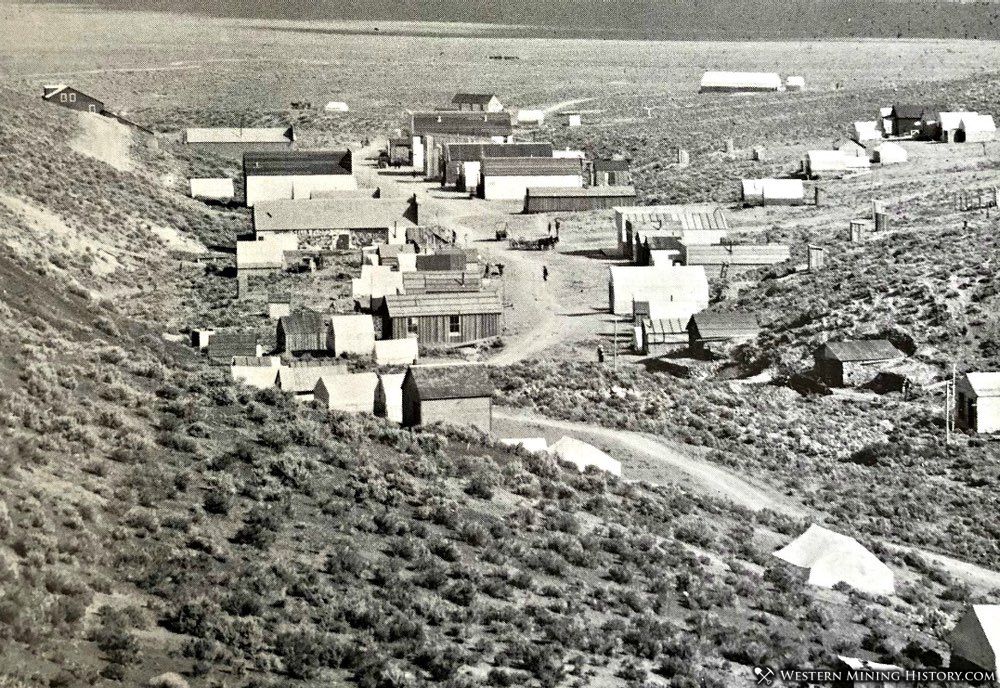The discovery of gold or silver in the West was usually followed by a rush of people attempting to arrive at the new district first to get established in mining or business. New mining camps were hastily constructed out of materials that could be easily transported over great distances and on difficult terrain. The most common early structure in these camps was the canvas tent.

Larger rushes, like the 1904 Bullfrog excitement in Nevada, resulted in tent cities with thousands of residents. The following image gives an overhead view of the town of Bullfrog during in its earliest days.

Tents were used for both shelter and to operate early businesses in the camps. The entrepreneur with the tent could be in business weeks before his rivals who attempted to build a more elaborate structure, and those first few weeks were a lucrative time to be selling goods or services to the hundreds or even thousands of people pouring into a new camp.
Below is “Matts American Kitchen” at Cripple Creek, Colorado. Meals are just 25 cents.

The following image shows a lunchroom during the early years at Cripple Creek, Colorado. Hot soup, sandwiches, coffee, and even oysters are on the menu.

The following image appears to be of a newspaper being distributed out of a canvas building in Goldfield, Nevada ca. 1905. The sign on the cart reads “Daily and Sunday – On Sale Here.” It is unclear if the newspapers nailed to the side of the building and the door are for advertisement, insulation, or both.

In what was certainly Nevada’s finest hotel, the Goldfield Waldorf-Astoria is seen here in all its opulence. “Come in and Eat” is written by the door.

One of the most popular businesses that were run out of tents were saloons and restaurants. Boom towns would have hundreds of new arrivals that were traveling with few supplies, and inevitably they would need food and entertainment.

Restaurants in tents were a common sight in early camps. The following image depicts the “Ja-Ha-Bich” restaurant in Jarbidge, Nevada. The sign on the establishment reads “Home made bread, pie, cake, and doughnuts.”

This next view shows both the restaurant at Jarbidge, and the adjacent hotel – in a tent of course.

Although restaurants and saloons were the most common businesses run out of tents, just about every kind of business was run out of tents at one point or another. The following photo shows “Hawley Puckett Attorney at Law, Notary Public” ca. 1903 in Thunder Mountain, Idaho.

Another advantage of tents is that they could be packed up and moved to the next camp in the event that the rush to the current camp turned out to be a bust. Many mining rushes were the result of misinformation or outright fraud. People who’s only investment in the camp was a tent on the ground could pack up and move on to the next rush with little trouble.

Tents could also be used for any structure where other materials were not available. The following photo show a tent as the only building at a small mine in the Cripple Creek district of COlorado.

Tent cities usually didn’t last more than a year. Any camp that proved to have rich enough mines to last longer than a season would usually transition to wood buildings fairly quickly. The following photo shows Rawhide, Nevada in transition from a large tent camp to a more permanent town with wood construction.

However, Rawhide didn’t get the chance to full transition into a wood-framed town before most of it burned in a devastating 1908 fire.

Sometimes great mining cities had to rely on tents in the aftermath of a disaster. The following photo depicts tent buildings serving as temporary shelter after the devastating April, 1896 fire that burned much of Cripple Creek, Colorado.

Mazuma, Nevada was one of several towns settled during the Seven Troughs rush of 1907. The publication Mining Investor called Mazuma the “central town in the district” and stated that Mazuma was in “an excellent location, being at the mouth of Seven Troughs canon”.
In July 1912, a cloudburst in the Seven Troughs range sent a 20 foot wall of water crashing down on Mazuma, killing at least 12 people and destroying most of the town. Mazuma was never rebuilt.

The 1920’s were the final days of the great mining era in the West. New discoveries were rare during this decade, but a few were made nonetheless. Even in 1927, at Nevada’s last rush at Weepah, the tent was the defining feature of the new camp.

The Eureka district of Washington state was first settled in 1896. The photo below shows the earliest camp, composed mostly of tents. The camp would later evolve into the town known as Republic in what was the state’s richest gold district.

Even in the far north, the canvas tent was a common form of shelter in young boom towns. Seen below is a tent camp outside of Nome, Alaska. Thousands of miners lived in these camps that stretched for tens of miles along the beaches of Nome.

Although often overlooked, the white canvas tent was an important tool in the settlement of new mining districts in the West. Luckily many photos of early tent camps were preserved so that we can witness the earliest development of these iconic camps.
Miners Cabins: Bottles, Barrels, and Dugouts
While the miners and prospectors that opened the vast American West are known for the log cabins they often used for shelter, some of the more eccentric dwellings they built are lesser known but equally interesting. “Miners Cabins: Bottles, Barrels, and Dugouts” takes a look at some of the more eccentric dwellings used by early miners.
